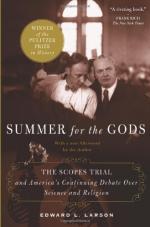
|
| Name: _________________________ | Period: ___________________ |
This test consists of 15 multiple choice questions and 5 short answer questions.
Multiple Choice Questions
1. What is it that Larson shows that helps put the ACLU into a position to test the Tennessee law and defend Scopes?
(a) Darrow agrees to defend.
(b) Its origins.
(c) That law holds a criminal penalty.
(d) Locating a willing teacher.
2. How many conservatives gather at the first World's Christian Fundamentals Association conference in 1919?
(a) 600.
(b) 600,000.
(c) 60,000.
(d) 6,000.
3. Because of the shape and size of the Piltdown skull, scientists at that time believe it is a what?
(a) Homoousian.
(b) Hominoid.
(c) Homogenate,
(d) Homocysteine.
4. The author identifies the timing of the anti-evolution movement of the 1920s is due in part to what?
(a) Growth of private schools.
(b) College growth.
(c) Growth of public, private schools.
(d) Growth of public schools.
5. Bryan is caught between arguing for a literal interpretation of the Bible and accommodating facts about what?
(a) Evolution.
(b) Geology, the solar system.
(c) Geology, biology.
(d) Biology, the solar system.
6. Futile attempts of the ACLU in cases before Scopes' trial are likely because of what general attitude during and directly after World War I?
(a) Antisocialism, capitalism.
(b) Anticommunism, patriotism.
(c) Fundamentalism, patriotism.
(d) Anticommunism, fundamentalism.
7. The ACLU sees Tennessee's law against teaching evolution as part of a systematic "assault" on personal liberty, starting with limitations when?
(a) Spanish-American War.
(b) U.S. Civil War.
(c) Mexican-American War.
(d) World War I.
8. Some geologists reconcile biblical accounts with theories of the earth's lengthy geologic past and extinct species by positing how?
(a) Accounts of human life spans of hundreds of years are literal.
(b) Account of six days is literal rather than symbolic.
(c) Account of six days is symbolic rather than literal.
(d) Account of only lives on Noah's ark surviving a great flood is literal.
9. Darrow defends John Scopes for violating which laws, saying evolution cannot be taught in public schools?
(a) County.
(b) Federal.
(c) Municipal.
(d) State.
10. Bryan hears of the proposal to ban teaching evolution, and as he supports the idea in talks and writing, he does what else?
(a) Avoids addressing governmental bodies.
(b) Addresses joint sessions of the state's legislature.
(c) Addresses the state House of Representatives.
(d) Addresses the state Senate.
11. Darwin's view of random variations and survival-of-the-fittest pose problems for many Christians holding what view of nature?
(a) Physiological.
(b) Geological.
(c) Teleological.
(d) Biological.
12. When does John W. Butler propose it a misdemeanor to teach that man evolves, "from a lower order of animal" instead of the biblical account?
(a) 1923.
(b) A1921.
(c) 1925.
(d) 1919.
13. Larson's introduction serves as a preview of the Scopes trial and issues it raises for whom?
(a) American society.
(b) Teachers.
(c) School administrators.
(d) Tennessee society.
14. World War I plays an important role in the tensions between modernists and fundamentalists as what happens?
(a) Many fundamentalists support the war, and global affairs intervention.
(b) Nearly all modernists support the war, and global affairs intervention.
(c) Many modernists oppose the war, and global affairs intervention.
(d) Many modernists support the war, and global affairs intervention.
15. The ACLU fights curricula, especially any promoting patriotism openly and labeling anything what as bad?
(a) Marxist.
(b) Foreign.
(c) Darwinian.
(d) Atheistic.
Short Answer Questions
1. Larson shows that how many theories of evolutionary development fit nicely within a Christian explanation of the world?
2. After 1923, anti-evolutionists begin focusing on which state for legal action?
3. Universities begin incorporating tenure and academic freedom to protect the freedom of what?
4. Greater student numbers plus the growing fundamentalist movement means conservative Christian parents find what is coming into conflict?
5. What question does the Scopes trial rest on?
|
This section contains 602 words (approx. 3 pages at 300 words per page) |

|




